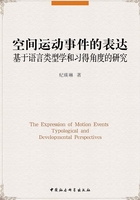
CHAPTER 1 Space in language typology andlanguage acquisition
It has long been accepted that the notion of space plays an important role in human activities and that spatial experience constitutes the earliest, most essential and most pervasive experience of human life (Johnson 1987, Landau and Zukowski 2003).The perception of where an object is with respect to our bodies or to larger surroundings and the ability to orient ourselves towards some destination by using spatial landmarks are clearly fundamental to our daily activities.Moreover, among the earliest things that young children enjoy doing is talking about objects and their motion through space (Landau and Zukowski 2003).An essential spatial understanding of the surrounding world is actually already present in babies who know for instance that a toy car set midair will certainly fall (Bowerman 1999 and Levinson 2003).
Space is universal because spatial concepts regarding entities and relations among them are constrained by our biological endowment, the visual and the haptic-kinaesthetic system in particular.Given the importance of space in human activities, the research into it can be traced back at least to Kant's philosophical notion of absolute space.In the last thirty years or so this principal cognitive domain with the above-mentioned specific properties increasingly attracts the attention of researchers in varied disciplines of language, cognition and psychology.In this context, this book aims to investigate spatial reference, particularly the expression of motion events from both typological and acquisitional points of view.